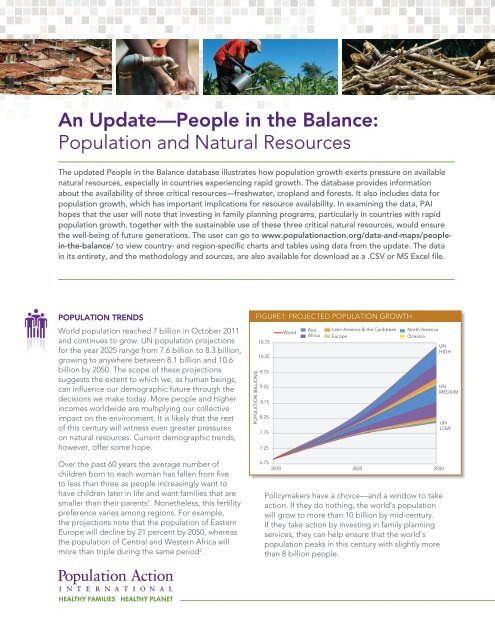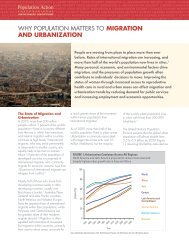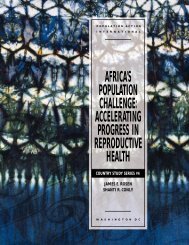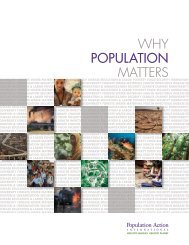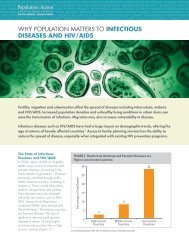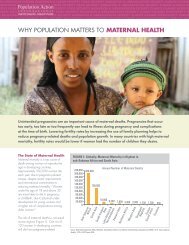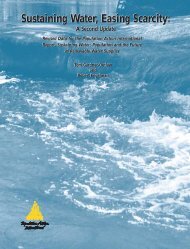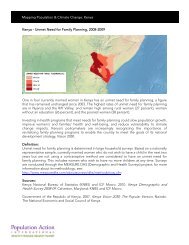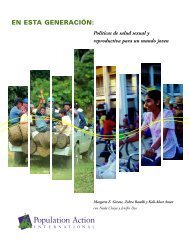an updateâPeople in the Balance: Population and Natural Resources
an updateâPeople in the Balance: Population and Natural Resources
an updateâPeople in the Balance: Population and Natural Resources
Create successful ePaper yourself
Turn your PDF publications into a flip-book with our unique Google optimized e-Paper software.
An Update—People <strong>in</strong> <strong>the</strong> Bal<strong>an</strong>ce:<br />
<strong>Population</strong> <strong>an</strong>d <strong>Natural</strong> <strong>Resources</strong><br />
The updated People <strong>in</strong> <strong>the</strong> Bal<strong>an</strong>ce database illustrates how population growth exerts pressure on available<br />
natural resources, especially <strong>in</strong> countries experienc<strong>in</strong>g rapid growth. The database provides <strong>in</strong>formation<br />
about <strong>the</strong> availability of three critical resources—freshwater, cropl<strong>an</strong>d <strong>an</strong>d forests. It also <strong>in</strong>cludes data for<br />
population growth, which has import<strong>an</strong>t implications for resource availability. In exam<strong>in</strong><strong>in</strong>g <strong>the</strong> data, PAI<br />
hopes that <strong>the</strong> user will note that <strong>in</strong>vest<strong>in</strong>g <strong>in</strong> family pl<strong>an</strong>n<strong>in</strong>g programs, particularly <strong>in</strong> countries with rapid<br />
population growth, toge<strong>the</strong>r with <strong>the</strong> susta<strong>in</strong>able use of <strong>the</strong>se three critical natural resources, would ensure<br />
<strong>the</strong> well-be<strong>in</strong>g of future generations. The user c<strong>an</strong> go to www.populationaction.org/data-<strong>an</strong>d-maps/people<strong>in</strong>-<strong>the</strong>-bal<strong>an</strong>ce/<br />
to view country- <strong>an</strong>d region-specific charts <strong>an</strong>d tables us<strong>in</strong>g data from <strong>the</strong> update. The data<br />
<strong>in</strong> its entirety, <strong>an</strong>d <strong>the</strong> methodology <strong>an</strong>d sources, are also available for download as a .CSV or MS Excel file.<br />
<strong>Population</strong> Trends<br />
World population reached 7 billion <strong>in</strong> October 2011<br />
<strong>an</strong>d cont<strong>in</strong>ues to grow. UN population projections<br />
for <strong>the</strong> year 2025 r<strong>an</strong>ge from 7.6 billion to 8.3 billion,<br />
grow<strong>in</strong>g to <strong>an</strong>ywhere between 8.1 billion <strong>an</strong>d 10.6<br />
billion by 2050. The scope of <strong>the</strong>se projections<br />
suggests <strong>the</strong> extent to which we, as hum<strong>an</strong> be<strong>in</strong>gs,<br />
c<strong>an</strong> <strong>in</strong>fluence our demographic future through <strong>the</strong><br />
decisions we make today. More people <strong>an</strong>d higher<br />
<strong>in</strong>comes worldwide are multiply<strong>in</strong>g our collective<br />
impact on <strong>the</strong> environment. It is likely that <strong>the</strong> rest<br />
of this century will witness even greater pressures<br />
on natural resources. Current demographic trends,<br />
however, offer some hope.<br />
Over <strong>the</strong> past 60 years <strong>the</strong> average number of<br />
children born to each wom<strong>an</strong> has fallen from five<br />
to less th<strong>an</strong> three as people <strong>in</strong>creas<strong>in</strong>gly w<strong>an</strong>t to<br />
have children later <strong>in</strong> life <strong>an</strong>d w<strong>an</strong>t families that are<br />
smaller th<strong>an</strong> <strong>the</strong>ir parents 1 . None<strong>the</strong>less, this fertility<br />
preference varies among regions. For example,<br />
<strong>the</strong> projections note that <strong>the</strong> population of Eastern<br />
Europe will decl<strong>in</strong>e by 21 percent by 2050, whereas<br />
<strong>the</strong> population of Central <strong>an</strong>d Western Africa will<br />
more th<strong>an</strong> triple dur<strong>in</strong>g <strong>the</strong> same period 2 .<br />
POPULATION (BILLIONS)<br />
Figure1: Projected <strong>Population</strong> Growth<br />
10.75<br />
10.25<br />
9.75<br />
9.25<br />
8.75<br />
8.25<br />
7.75<br />
7.25<br />
World<br />
Asia<br />
Africa<br />
Lat<strong>in</strong> America & <strong>the</strong> Caribbe<strong>an</strong><br />
Europe<br />
North America<br />
Oce<strong>an</strong>ia<br />
6.75<br />
2010 2025 2050<br />
Policymakers have a choice—<strong>an</strong>d a w<strong>in</strong>dow to take<br />
action. If <strong>the</strong>y do noth<strong>in</strong>g, <strong>the</strong> world’s population<br />
will grow to more th<strong>an</strong> 10 billion by mid-century.<br />
If <strong>the</strong>y take action by <strong>in</strong>vest<strong>in</strong>g <strong>in</strong> family pl<strong>an</strong>n<strong>in</strong>g<br />
services, <strong>the</strong>y c<strong>an</strong> help ensure that <strong>the</strong> world’s<br />
population peaks <strong>in</strong> this century with slightly more<br />
th<strong>an</strong> 8 billion people.<br />
UN<br />
HIGH<br />
UN<br />
MEDIUM<br />
UN<br />
LOW<br />
HEALTHY FAMILIES HEALTHY PLANET
People <strong>an</strong>d Water<br />
As global population <strong>in</strong>creases, so does <strong>the</strong> dem<strong>an</strong>d<br />
for water. Today, more th<strong>an</strong> 2 billion people live <strong>in</strong><br />
47 countries that are experienc<strong>in</strong>g water stress or<br />
scarcity. By 2025, based on <strong>an</strong> estimate of medium<br />
projections of population growth, even more people<br />
(more th<strong>an</strong> 3.1 billion) may live under water-scarce<br />
or water-stressed conditions. For millions of people<br />
currently <strong>in</strong> <strong>the</strong> Middle East <strong>an</strong>d North Africa region,<br />
fresh water shortages are a chronic concern that is<br />
becom<strong>in</strong>g <strong>in</strong>creas<strong>in</strong>gly acute. The problem is worse<br />
th<strong>an</strong> it often appears, because much of <strong>the</strong> fresh<br />
water now used <strong>in</strong> water-scarce regions comes<br />
Figure 2: CURRENT AND PROJECTED POPULATION AND WATER AVAILABILITY<br />
Water Scarce: 2010<br />
Water Stressed: 2010<br />
Relative Sufficiency<br />
No Data<br />
PROJECTED POPULATION LIVING IN WATER STRESSED OR SCARCE COUNTRIES<br />
2010<br />
2050<br />
397 million SCARCE 2.1 billion<br />
1.6 billion<br />
2.0 billion<br />
STRESSED<br />
TOTAL<br />
2.0 billion<br />
4.1 billion<br />
Figure 3: CURRENT AND PROJECTED POPULATION AND CROPLAND AVAILABILITY<br />
Cropl<strong>an</strong>d Scarce: 2010<br />
Cropl<strong>an</strong>d Stressed: 2010<br />
Relative Sufficiency<br />
No Data<br />
PROJECTED POPULATION LIVING IN CROPLAND STRESSED OR SCARCE COUNTRIES<br />
2010<br />
2050<br />
508 million SCARCE 1.3 billion<br />
4.0 billion<br />
4.5 billion<br />
STRESSED<br />
TOTAL<br />
6.0 billion<br />
7.3 billion
from over-pumped groundwater reserves that are<br />
not be<strong>in</strong>g replenished by ra<strong>in</strong>fall or snowmelt 3 .<br />
Increas<strong>in</strong>g variability of precipitation patterns<br />
result<strong>in</strong>g from climate ch<strong>an</strong>ge fur<strong>the</strong>r complicates<br />
such water challenges 4 . In most of <strong>the</strong> countries<br />
where water shortage is severe <strong>an</strong>d worsen<strong>in</strong>g, high<br />
rates of population growth exacerbate <strong>the</strong> decl<strong>in</strong><strong>in</strong>g<br />
availability of renewable fresh water.<br />
People <strong>an</strong>d Cropl<strong>an</strong>d<br />
Global food production depends on two critical<br />
<strong>in</strong>puts: cropl<strong>an</strong>d <strong>an</strong>d water availability. These two<br />
<strong>in</strong>puts are currently under pressure from <strong>in</strong>creas<strong>in</strong>g<br />
hum<strong>an</strong> population. Cropl<strong>an</strong>d acreage <strong>in</strong> some key<br />
food-produc<strong>in</strong>g countries has begun shr<strong>in</strong>k<strong>in</strong>g<br />
as a result of compet<strong>in</strong>g l<strong>an</strong>d use pressures such<br />
as urb<strong>an</strong>ization 5 . The number of people liv<strong>in</strong>g <strong>in</strong><br />
countries where cultivated l<strong>an</strong>d is critically scarce<br />
is projected to <strong>in</strong>crease from 508 million today<br />
to between 903 million <strong>an</strong>d 2.1 billion by 2050.<br />
Pressure on cropl<strong>an</strong>d often leads to <strong>the</strong> destruction<br />
of critical forest reserves, or <strong>the</strong> overexploitation<br />
of l<strong>an</strong>d. This l<strong>an</strong>d overexploitation <strong>in</strong>creases <strong>the</strong><br />
possibility that staple crop production will fail,<br />
ultimately underm<strong>in</strong><strong>in</strong>g food availability. Ensur<strong>in</strong>g<br />
food security <strong>in</strong> <strong>the</strong> world’s poorest regions will<br />
become progressively difficult if population growth<br />
cont<strong>in</strong>ues grow<strong>in</strong>g as is projected.<br />
People <strong>an</strong>d Forests<br />
Forest resources <strong>an</strong>d <strong>the</strong>ir products are essential<br />
for hum<strong>an</strong> well-be<strong>in</strong>g. Overall, <strong>the</strong>y contribute to<br />
our development through preserv<strong>in</strong>g biodiversity,<br />
purify<strong>in</strong>g water <strong>an</strong>d air, provid<strong>in</strong>g raw materials,<br />
<strong>an</strong>d offer<strong>in</strong>g opportunities for recreation. Most<br />
of <strong>the</strong> world’s forests are be<strong>in</strong>g lost due to<br />
exp<strong>an</strong>sion of hum<strong>an</strong> activities, particularly <strong>in</strong> <strong>the</strong><br />
agricultural sector <strong>an</strong>d through urb<strong>an</strong>ization. While<br />
deforestation rates are currently decl<strong>in</strong><strong>in</strong>g <strong>in</strong> several<br />
countries, <strong>the</strong>y are is still high <strong>in</strong> o<strong>the</strong>rs 6 . The<br />
future availability of forest resources for food, fuel<br />
<strong>an</strong>d shelter looks discourag<strong>in</strong>g <strong>in</strong> those countries<br />
experienc<strong>in</strong>g high deforestation rates. Currently,<br />
more th<strong>an</strong> 2.3 billion people live <strong>in</strong> 51 countries with<br />
less th<strong>an</strong> 0.1 hectare of forested l<strong>an</strong>d per person,<br />
<strong>an</strong> <strong>in</strong>dicator of critically low levels of forest cover.<br />
Based on current deforestation trends, <strong>the</strong> number<br />
of people liv<strong>in</strong>g <strong>in</strong> forest-scarce countries may<br />
<strong>in</strong>crease to 3.1 billion by 2025 <strong>an</strong>d to 4.1 by 2050.<br />
Forests also play <strong>an</strong> import<strong>an</strong>t role <strong>in</strong> mitigat<strong>in</strong>g <strong>an</strong>d<br />
adapt<strong>in</strong>g to <strong>the</strong> impacts of climate ch<strong>an</strong>ge. While<br />
forests have <strong>the</strong> capacity to absorb greenhouse<br />
gases from <strong>the</strong> atmosphere, when destroyed,<br />
overexploited or burned, <strong>the</strong>y c<strong>an</strong> serve as a source<br />
of CO 2<br />
emissions. Rapid deforestation, coupled with<br />
climate ch<strong>an</strong>ge, will cause <strong>the</strong> loss of livelihoods of<br />
millions of people who depend directly on forest<br />
resources. It will also <strong>in</strong>crease <strong>the</strong> concentration of<br />
greenhouse gases <strong>in</strong> <strong>the</strong> atmosphere.<br />
Figure 4: CURRENT AND PROJECTED POPULATION AND FOREST COVER<br />
Low Forest Cover: 2010<br />
Sufficient Forest Cover<br />
No Data<br />
PROJECTED POPULATION LIVING IN COUNTRIES WITH LOW FOREST COVER<br />
4.5<br />
3.0<br />
1.5<br />
0<br />
2.3 billion<br />
2010<br />
4.1 billion<br />
2050
Policy Considerations<br />
The environmental <strong>an</strong>d hum<strong>an</strong> challenges aris<strong>in</strong>g<br />
from natural resource scarcity will become more<br />
difficult to address if <strong>the</strong> number of people on <strong>the</strong><br />
pl<strong>an</strong>et cont<strong>in</strong>ues to <strong>in</strong>crease. <strong>Population</strong> dynamics<br />
<strong>in</strong>fluence resource availability on local, regional <strong>an</strong>d<br />
global levels. Incorporat<strong>in</strong>g population <strong>an</strong>d family<br />
pl<strong>an</strong>n<strong>in</strong>g policies <strong>in</strong>to national development pl<strong>an</strong>s<br />
is central to ensur<strong>in</strong>g susta<strong>in</strong>able population growth<br />
<strong>an</strong>d development. Such development pl<strong>an</strong>s should<br />
emphasize access to reproductive health services,<br />
to education <strong>an</strong>d to economic opportunities; ensure<br />
improved energy <strong>an</strong>d natural resource technology<br />
development <strong>an</strong>d use; <strong>an</strong>d lower consumption levels,<br />
particularly <strong>in</strong> <strong>in</strong>dustrialized countries. Toge<strong>the</strong>r,<br />
<strong>the</strong>se c<strong>an</strong> help us bal<strong>an</strong>ce environmental protection,<br />
natural resource use, <strong>an</strong>d hum<strong>an</strong> well-be<strong>in</strong>g.<br />
Notes<br />
1 United Nations <strong>Population</strong> Division, Department of Economic <strong>an</strong>d Social Affairs from World <strong>Population</strong> Prospects: The 2010 Revision<br />
2 Guttmacher Institute <strong>an</strong>d United Nations <strong>Population</strong> Fund. 2009. Add<strong>in</strong>g It Up: The Cost <strong>an</strong>d Benefits of Invest<strong>in</strong>g <strong>in</strong> Family Pl<strong>an</strong>n<strong>in</strong>g <strong>an</strong>d Maternal<br />
<strong>an</strong>d Newborn Health. New York: Guttmacher Institute <strong>an</strong>d UNFPA.<br />
3 Brown L. R.2006 Pl<strong>an</strong> B 2.0: rescu<strong>in</strong>g a pl<strong>an</strong>et under stress <strong>an</strong>d a civilization <strong>in</strong> trouble. New York, NY: W.W. Norton & Comp<strong>an</strong>y<br />
4 <strong>Population</strong> Action International (PAI)’s Mapp<strong>in</strong>g <strong>Population</strong> <strong>an</strong>d Climate Ch<strong>an</strong>ge website: http://www.populationaction.org/Publications/<br />
Interactive_Databases/climate_map.shtml<br />
5 Prasad S. Thenkabail. 2010. Global Cropl<strong>an</strong>ds <strong>an</strong>d <strong>the</strong>ir Import<strong>an</strong>ce for Water <strong>an</strong>d Food Security <strong>in</strong> <strong>the</strong> Twenty-first Century: Towards <strong>an</strong> Ever<br />
Green Revolution that Comb<strong>in</strong>es a Second Green Revolution with a Blue Revolution. Remote Sens<strong>in</strong>g 2010 (2), 2305-2312<br />
6 Food <strong>an</strong>d Agriculture Org<strong>an</strong>ization of <strong>the</strong> United Nations, 2010. Global Forest <strong>Resources</strong> Assessment 2010. Rome: FAO<br />
1300 19th Street, NW I Second Floor I Wash<strong>in</strong>gton, DC 20036 USA<br />
Tel: +202.557.3400 I Fax: +202.728.4177 I wwww.populationaction.org I Email: pai@popact.org<br />
HEALTHY FAMILIES HEALTHY PLANET<br />
<strong>Population</strong> Action International advocates for women <strong>an</strong>d families to have access to contraception <strong>in</strong> order to improve <strong>the</strong>ir health,<br />
reduce poverty <strong>an</strong>d protect <strong>the</strong>ir environment.<br />
© <strong>Population</strong> Action International, 2012. Contents of this <strong>an</strong>d accomp<strong>an</strong>y<strong>in</strong>g materials may be reproduced provided <strong>Population</strong> Action International is acknowledged as <strong>the</strong> source.


